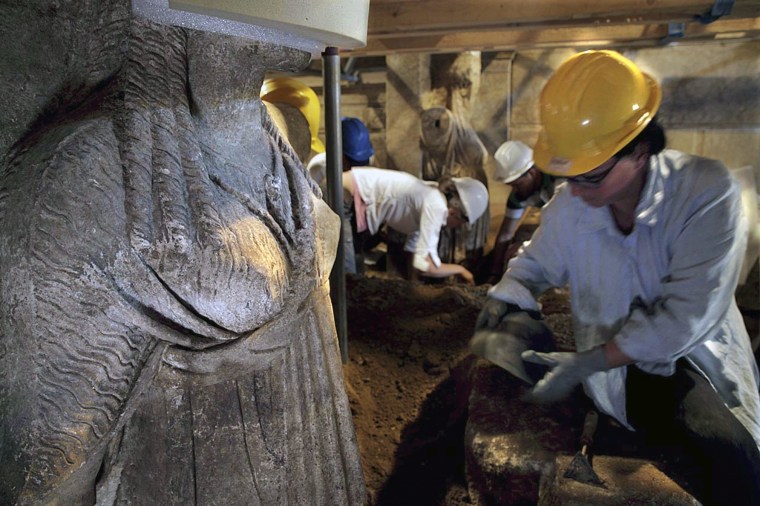Archaeologists have uncovered the expertly crafted robes of two female stone statues standing guard at the entrance of a huge Macedonian tomb, dating back to the era of Alexander the Great, under excavation in Greece.
Excavators got their first glimpse of the wavy-haired statues — known as caryatids — last weekend, when the stone heads and torsos were unearthed at the ancient burial complex at Kasta Hill in Amphipolis, 65 miles (104 kilometers) east of Thessaloniki. Archaeologists had to remove a wall of sealing stones to reveal the rest of the statues' bodies.
Gaze Into the Face of a Caryatid

Anyone who has visited the Acropolis in Athens and stood in front of the Erechtheion would be familiar with caryatids, or female statues that take the place of columns or pillars. Though carved from stone, the diaphanous robes of the caryatids at Amphipolis have "exceptional" folds, officials with the Greek Ministry of Culture said in a statement Thursday. [See Photos of the Alexander-Era Tomb Excavation]
"The right arm of the western caryatid and the left arm of the eastern one are both outstretched, as if to symbolically prevent anyone attempting to enter the grave," the ministry said.
The ongoing excavations at Amphipolis have been watched with excitement over the past several weeks. Two headless sphinxes were uncovered at the entrance of the huge burial mound, which is enclosed by a marble wall measuring 1,600 feet (490 meters) around the perimeter,
Lead archaeologist Katerina Peristeri has said the team believes the tomb dates back to the fourth century B.C. and was built by Dinocrates, Alexander the Great's chief architect. The excavators have been tight-lipped about who they think might be buried inside. Some say the tomb might belong to one of Alexander's generals or family members. But it almost certainly doesn't contain the body of Alexander the Great himself — historical accounts indicate he was buried in Alexandria, though his remains have never been found.
— Megan Gannon, LiveScience
This is a condensed version of a report from LiveScience. Read the full report. Follow Megan Gannon on Twitter and Google+. Follow LiveScience on Twitter, Facebook andGoogle+.
